by Jessica Kosinski
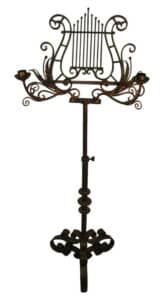
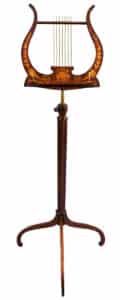
music stand with decorative inlay
In the world of music, there are many instruments you could choose to play. However, deciding on an instrument is not the only choice needed to be made. For an orchestra, for example, comfortable seating is important. So is a conductor’s baton. Equally important is the sheet music each member has to read. We can all agree on those things, but one piece of equipment used at one time or another by most musicians is often overlooked: a music stand. Let’s take a peek at just what makes some music stands really stand out as not just tools of the trade, but also as works of art.
What a Music Stand Is
The basic definition of a music stand is a stand that holds sheet music. Such a stand allows a musician to easily read the music necessary to play his or her instrument. However, when we peek a bit further into the subject of music stands, it is clear that there is more to music stands than a simple easel of sorts. They come in several different styles and designs.
The Birth of Music Stands
The birth of music stands is somewhat debated. Nobody knows exactly when the first one was invented. However, some believe they got their start in Ancient China. When reviewing a timeline, it was not until the 1300s when they started to become popular – and not in China. In fact, Swiss and German citizens are the ones known for popularizing the use of such stands at that time.
Standard Music Stands
Today’s typical music stands used during major concerts are fairly basic and uniform in nature. They are usually metal and black. Typically, they have adjustable tilt angles and heights. Often, they have matte finishes to make them as inconspicuous as possible during performances.
Music Desks
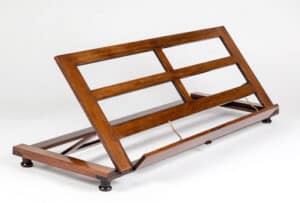
As the name implies, a music desk is a desk that holds sheet music. Unlike a music stand, it does not have a pole or pedestal. Nor does it have a tripod-like shape. Instead, it is essentially a table with a sloped top, much like a cookbook stand works in today’s kitchens. Pianos often have built-in music desks.
Utilitarian Versus Decorative/Unusual Music Stands
It is important to make a distinction between utilitarian and decorative music stands. All music stands serve the same purpose, but some do so in a purely functional way. Others are designed to be both functional and works of art. It is such decorative music stands that are often prized by the world’s top musicians and music enthusiasts. Other music stands stand out less for being decorative and more for being unusual in terms of design.
The Jefferson Music Stand
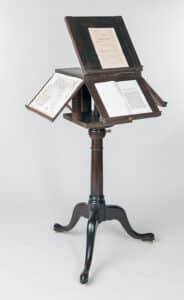
As you may know, Thomas Jefferson was the third President of the United States. He also held many other political titles and was the primary creator of the Declaration of Independence. What you may not know is that he was also an inventor. One of the things he invented was a stand that was, at least at first, thought to be a music stand.
In reality, he used the unique stand to hold up to five documents at once. It revolved, allowing him to easily access each of them as needed. Sometimes those documents were letters or reference work or books. Nevertheless, many stands of the type he invented have been used to hold sheet music that may be excessive in length that required the music to be spread across several surfaces. Also, a group of musicians such as a quartet would use such a stand together as a group without the encumbrance of having four separate stands. Jefferson never patented the design, allowing it to be reproduced many times .
Wharton Esherick Music Stands
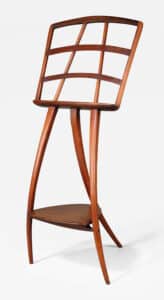
Wharton Esherick wooden music stands are quite popular. Esherick, who passed away in 1970, is known for starting the studio furniture movement in the United States. He also designed music stands, including a double design capable of holding two pieces of sheet music at once. Such stands are known as “duet” stands.
Despite being popular for how they look, Esherick’s stands are often considered rougher than others in terms of their designs. Because he dabbled in several different mediums rather than specializing in woodworking, the stands had certain flaws others noted in his chosen design styles.
Yet, they are still prized by many collectors, even several decades after his death.
Collecting Decorative Music Stands
There are many different decorative music stand designs you can find today. Several of them incorporate the shape of a musical instrument, such as the lyre, into their designs. A lyre is a stringed instrument that is essentially a hand-held harp. Other music stands are prized for elements and materials they incorporate from the regions, countries, and years in which they were produced. For example, a music stand made in North America in the Victorian period may be made of different materials and in a different style from one made in England at that same time.
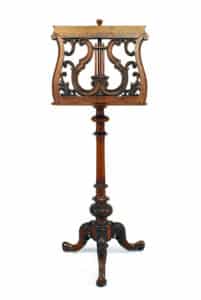
Values vary greatly from one material and region to another. For example, a Victorian music stand made in England using rosewood sold for almost $600 in 2020. However, French music stands from that period tend to often have higher price tags. Some French Victorian music stands can sell for thousands of dollars.
If you are looking for a decorative antique music stand, consider the design elements, era, and region where it was created (for different types of wood) would you are most interested in before you make a purchase. That way, especially if you are a musician intending to use the stand, you can choose one that is both useful and aesthetically pleasing to you and your audience. Also, do not get too focused on one style. Remember, music stands come in many different shapes and styles. Although many of the most decorative are made out of wood, they come in other mediums, including iron. France created some of the most intricate and decorative examples.





Related posts: